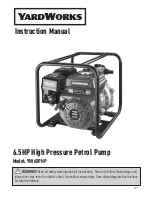
4
47109509_ed2
General Instructions
1. When grasping a tool or part in a vise, always use leather–covered
or copper–covered vise jaws to protect the surface of the part
and help prevent distortion. This is particularly true of threaded
members and housings.
2. Always press on the inner ring of a ball–type bearing when
installing the bearing on a shaft.
3. Always press on the outer ring of a ball–type bearing when
pressing the bearing into a bearing recess.
4. Except for bearings and mechanism parts, always clean every part
and wipe every part with a thin film of oil before installation.
5. Wipe a thin film of mechanism fluid on all internal mechanism
components before installing them in the mechanism.
6. Apply a film of O–ring lubricant to every O–ring before
installation.
Assembly of the Motor
1. Thread the Inlet Bushing (13) into the threaded hole at the rear
of the handle of the Motor Housing (1) and tighten it between 30
and 35 ft–lb (40 and 47 Nm) torque.
2. Position the Exhaust Deflector Assembly (14) in the hole at
the rear of the motor housing handle and install the Deflector
Retaining Pin (15) to secure it in position.
NOTICE
It may be necessary to slide the Assembly in or out in order to
align the groove in the Assembly with the pin hole.
3. Install the Reverse Valve Seal (6) in the groove next to the large
hub of the Reverse Valve (5).
4. Install the Reverse Valve Assembly, seal end trailing, into the lever
side of the Motor Housing. Make certain the square depression
on the shaft of the Valve faces forward toward the output end of
the tool.
5. Install the Reverse Lever Seal (3) in the groove on the small hub of
the Reverse Lever (2).
6. Insert the Throttle Ball (10) followed by the Throttle Valve Spring
(9) into the Reverse Valve Assembly.
7. Position the Reverse Lever Assembly on the Reverse Valve
Assembly with the indicator lever rearward. Make certain the
crossholes in the Lever align with the pin holes in the Valve. Press
the Reverse Lever Pin (4) into the Lever and Valve.
8. Insert the Throttle Plunger (11) into the Reverse Valve Assembly.
9. Position the Throttle Lever (7) on the Motor Housing and secure it
by pressing the Throttle Lever Pin (8) into the Housing and Lever.
10. Using an arbor press and a piece of tubing that contacts the outer
ring of the bearings, press the Front End Plate Bearing (27) into
the Front End Plate (25) and the Rear End Plate Bearing (19) into
the Rear End Plate (18).
Refer to Dwg. TPD1300.
Bearing
Tubing
End Plate
(Dwg. TPD1300)
12. Stand the Rotor (23) on the table of an arbor press. It should be
upright on a flat metal plate having a clearance hole for the shaft.
The shaft with the hex must be upward.
4. Remove the motor from the vise jaws and remove the Front End
Plate (24), Front End Plate Bearing (26), Cylinder Assembly (19)
and Vanes (23) from the Rotor.
5. On the table of an arbor press, support the Rear End Plate (25)
with blocks as close to the Rotor as possible and press the Rotor
out of the Rear End Plate and Rear Rotor Bearing (26).
6. To remove the Rear Rotor Bearing from the Rear End Plate, use a
small drift or pin punch through the central opening of the Rear
End Plate to tap the Bearing out of the End Plate.
Refer to Dwg. TPD1299.
NOTICE
Do not enlarge or damage the shaft hole in the End Plate.
(Dwg. TPD1299)
7. Press the Reverse Lever Pin (4) out of the Reverse Lever (2) and
remove the Reverse Lever, Reverse Lever Seal (3), Throttle Valve
Spring (9) and the Throttle Ball (10).
8. Spread the end of the Suspension Bail (16), where the ends enter
the Motor Housing, and remove the Bail.
9. Using a pin punch, tap the Throttle Lever Pin (8) and the Deflector
Retaining Pin (15) out of the Handle. Remove the Throttle Lever
(7), Throttle Plunger (11) and the Exhaust Deflector Assembly (14).
10. Push the Reverse Valve Assembly (5) out the throttle lever end
of the Housing and Remove the two Reverse Valve Bushing Seals
(14) if they need to be replaced.
11. Unscrew and remove the Inlet Bushing (13).
Assembly


























